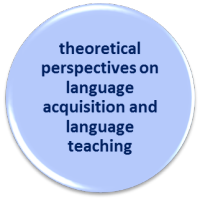Delta Module One Course
 |
Syllabus area 1
|
 |
This section of the course covers the first area of the Delta syllabus for Module One. At the end of this section, you should be able to:
|
This guide will lead you to both of those targets.
From time to time, you will invited to go off to guides on other parts
of this site to consolidate what you have learned and there will be some
worksheet tests of your understanding as we go along.
 |
An overview of what you need to know |
There are two competing ideas about where to start when designing ways to teach a foreign language.
 |
We learn a second language in the same way we learned our first language(s) |
Many theories which underlie classroom practice are based on an
intuitive but unproven assumption that replicating the ways in which
we acquired our first language will be inherently better than
teaching people about the language and hoping that this
will enable them to use it accurately to get things done.
Unfortunately, there is no profession-wide consensus concerning just
how we acquire our first language(s). The links, therefore,
between second-language teaching methodology and first-language
learning theories remain somewhat obscure. Simply put, any
second-language pedagogy based on a first-language acquisition
theory (or mix of theories) will reflect the preferred theory of
first-language learning.
For example, if you hold the belief that we learn our first language
by imitation of the language we hear around us, then you may be
inclined to develop a methodology containing a great deal of
modelling and repetition. If, on the other hand, you believe
that people learn their first language by hearing it and making,
confirming or adjusting hypotheses concerning how it is used and
structured, then you may be drawn to a second-language teaching
methodology which involves presenting people with lots of good data
about the language they are learning (i.e., rich examples of it in
use) and leading them to draw their own conclusions to develop an
internalised set of rules about structure and use.
There are, of course, a number of persuasive theories about how we
learn our first language and following the guides linked below will
help you understand them. From that, you can form a critical
understanding of those theories of second-language learning which
claim to replicate first-language acquisition.
 |
We learn a second language in a way fundamentally different from the way we learned our first language(s) |
A different point of view is one that holds that second-language
learning is a fundamentally different process from first-language
acquisition. Those who take this view will not be constrained
to make second-language learning methodology replicate whatever they
believe first-language acquisition involves.
This means that the focus can be shifted to ideas about how mature
brains operate and how memory, the assimilation of new data and so
on function. From this point of view, too, come considerations
of motivation, understanding the sources of error and so on.
For example, if you believe that human brains actively seek patterns
in the data they perceive around them to make sense of it, then much
of the effort to construct an effective teaching approach will focus
on language patterns rather than a more generalised view of the
natural and almost effortless picking up of language that children
are capable of doing. If, to present another example, you believe
that many language items are stored as usable, prefabricated chunks
then you may be drawn to a methodology which focuses on phrases and
collocating words to encourage language learning. If you don't
believe that and are convinced that we store language items
discretely in areas associated with their senses and shapes, then
your approach to teaching will be different.
The approaches outlined here are distinct but you will find a
good deal of overlap between them and some of the key concepts,
cognitivism vs. behaviourism, repetition and drilling vs. guided
discovery and communicative exercises and so on are common to both
schools of thought.
What will vary is the emphasis that is given to the concepts and how
strictly the methodology reflects the theory.
 |
First-language acquisition |
By the age of around six, most children have acquired their first
language – its grammar and its lexicon – and by the age of
eleven or so, children's language (voice tones aside) is
indistinguishable from that of adults.
Thereafter, all that remains is to develop greater stylistic range
and appropriacy along with an increased and more complex
lexicon.
The stages of language acquisition have been extensively researched
and recorded in literally hundreds of studies around the world and
do not concern us here. What does concern us is how children
achieve this enormous feat of memorisation and control in so short a
time.
It concerns us because a number of influential theorists have based
ideas about the best way to learn a second language on what they
understand are the way or ways in which we have acquired our first
language.
In brief, here is an overview of the main theories of first-language
acquisition:
- Innateness – language is in our genes

- It has been pointed out that the great rapidity of language
acquisition in children cannot be achieved by conventional
learning. So, it is posited, just like crawling, grasping,
smiling and walking, language is not something that has to be
learned, in the same way as, for example, playing chess or
riding a bicycle.
Language is acquired by children because they are genetically disposed to learn it. - Imitation – l say what I hear

- Children learn to speak the language(s) of the community in
which they are raised. A child of Urdu-speaking parents
will, if raised in a Russian-speaking community, speak Russian,
not Urdu. That much is obvious to most people now,
although it wasn't always.
When you hear or see the word parrot, for example, nothing in the form or the pronunciation of the word gives you the slightest clue to its meaning. You have to hear the word used in a meaningful context to be able to understand what it refers to, imitate it and use it correctly.
Imitation must, therefore, play a significant role or how else can we explain these simple facts? - Reinforcement of behaviours – l say
what I am encouraged to say

- Behaviourist learning theories are somewhat out of vogue.
The theories rest on the assumption that correct language output
which is both meaningful and appropriate will be rewarded (by
attention, praise, chocolate biscuits or whatever) and the
behaviour will, therefore, be reinforced and more likely to
recur.
On the other hand, incorrectly formed, inappropriate or meaningless language will not be reinforced and may, indeed, be negatively received by lack of parental attention or praise or even admonition and punishment.
Clearly, the theory has a lot in common with imitation theory and is often considered part of it. - Active construction of grammar – I
say what I assume to be right

- This theory depends on our accepting the simple premise that
we are all born with the ability to think about the world around
us. Language is part of that and we bring the same
cognitive powers to bear on it as we do with any other
phenomenon.
As we hear language around us and observe its use we make hypotheses about what it means and how it works. As more data come in, we refine the hypotheses and make new ones in a continuous process of construction and experiment. - Connectionism – I say what I reckon
will be right

- An allied theory is that we think statistically about
language and make connections with language we already know to
be correct. We do not experiment at random to make our
personal construction of hypotheses about language, we work on
what is most likely to be correct given what we already know is
correct.
We won't always be right but we will beat the odds on being wrong by simply guessing. - Social interaction – I learn to say what is
appropriate

- This theory is supplemental to others and suggests that we can only learn fully appropriate language effectively (however we learn it) if it is set in a social context with which we can relate and in which it carries real meaning
In a very small nutshell, these six theories are the most commonly espoused to explain, either alone or in combination, how humans acquire their first language(s).
Now, you have a task.
 |
|
Welcome back! Now click here for some comments.
There is no definitive right answer because some of your responses will be based on classroom techniques and approaches that you know about. There are, however, some commonalities you should have spotted.
- Techniques such as drilling, error correction, modelling and so on draw heavily on imitation and reinforcement theories.
- Social interaction theory underlies a good deal of
communicative language teaching and techniques such as role
play, project work and so on which rely on simulating or
enforcing contact with other speakers of the language.
In approaching skills, such elements as awareness of audience, turn-taking routines, authors' intentions, genre recognition, backchannelling and so on are also drawing on the theory. - Techniques such as noticing routines draw on theories of connectivism and active construction of grammar because it is necessary for learners to be aware of the language before they can process it cognitively.
- Inductive and guided discovery approaches draw heavily on theories of active construction of a working-hypothesis grammar in the learners.
- Syllabus designs are also heavily influenced by connectivist theories because some are written so that learners can easily draw analogies from the known to the target language.
You may have thought of more influences. Good if you did.
Regarding the evidence for and against the various theories, all that is set out in the guide so you can easily check what you have recalled by returning to the guide and looking, in particular for the introduction to each theory and at anything headed 'issues'.
 |
Theories of second-language acquisition |
This part should be easy.
Most of the theories of second-language acquisition can be traced to
those of first-language acquisition because that is the natural
order of things.
As we noted at the outset, there are two camps (with a good deal of
overlap):
- Those who believe that second-language acquisition closely parallels (or should) the way first languages are learned.
- Those who believe that learning a second or subsequent language is a qualitatively different undertaking from acquiring one's first language(s).
In the first camp, we find a number of theorists. In particular, people such as Krashen who took the view that deliberate learning of a language is unnecessary and that there is a distinction between acquiring a language (a mostly unconscious process) and learning a language (a conscious, organised and led process). We will also find innovators in this camp including James Asher, the developer of Total Physical Response learning and others.
In the second camp, we find those who assert that learning is a complex cognitive process which requires a focus on the language to be learned, elements of modelling, correction and drilling and a focus on context and scaffolding of learning.
 |
Four key contrasts |
In the Module One examination, you will be asked to analyse a
piece (or two) of teaching material and decide what the theory is
that the author(s) worked from when designing it.
There are four key distinctions you will need to draw on, among
other theories, to be able to do this successfully. They are
covered in more detail in the guide you will shortly be asked to
read but here's a summary:
- Competence vs. Performance
Competence is your general knowledge of the grammar of a language.
Performance is your actual use of the language in speaking and understanding it.
Materials will focus on one or the other either aimed at fluency (performance practice) or language analysis (increasing competence). - Use vs. Usage
This refers to the difference between the formal structures of the language and the language as it is used in real communication for authentic purposes.
Materials which focus on elucidating the structures and forms of language (controlled exercises in grammar, distinguishing phonemes, focusing on isolated subskills and so on) are concerned with usage. Those which focus on using the language in real or simulated authentic contexts are focused on use.
Usually a focus is applied to usage before use is considered, because people need time to get to grips with form before applying it in practice.
Task-based learning is an exception in that some forms of it focus immediately on use and only later on usage and language analysis / presentation. - Acquisition vs. Learning
This distinction lies at the heart of some of the theories of first-language acquisition we have already encountered. It is attributed to Krashen (to whom there is a separate guide on this site).
Acquisition is a process similar to the way in which some believe children acquire their first language(s). It requires meaningful and frequent interaction in the language in which the speakers are not focused on form but on meaning.
Learning is, in contrast, a formal procedure which focuses on the explanation of rules and correction of language form.
Materials which focus on exposure to authentic, contextualised language are focused on aiding acquisition. Those that require the learner to engage with the forms and structure of language and text take a learning approach. - Deductive vs. Inductive processing
Deductive processing involves the application of given rules to the data.
Materials which provide rules and then ask the learners to apply them to the data are focused on deductive cognitive processing.
Inductive processing works the other way around.
Materials which give lots of rich examples of the language in use and then require the learners to work out what the rules of use are, are focused on inductive cognitive processing. Inductive approaches are often characterised as discovery learning routines.
Now, you have a mini-task.
 |
|
Clearly, there is no right answer to this because nobody can
predict what you have selected. The object of the task was
just to get you thinking about how to surmise, based on what has
been produced, what the author of the material was thinking.
Look at the materials again and decide:
- Is the material aimed at competence or performance?
- Does it provide data on use or usage?
- Is it intended to lead to unconscious acquisition or conscious learning?
- Is it focused on deductive or inductive reasoning skills?
 |
Interior and exterior factors |
We have chosen here to divide ideas about how languages are
learned (or acquired) into factors which are internal to the
learners and factors which are external and under some control.
That is not, of course, the only way to do things.
 |
Internal factors |
- Behaviourism vs. Cognitivism

- This is the first great divide.
We saw in the consideration of first-language acquisition theories that one (reinforcement) depended on the assumption that learning a language is the application of a stimulus and a reaction to the response.
So, for example, a repeat-after-me drill in which the learners repeat what the teacher said, or a drill requiring learners to manipulate the language in a way parallel to an example is based on a process of habit formation which will be enhanced if the learners receive praise or are rewarded by noticeably better performance.
We saw, too, that some theorists consider language acquisition to be a process in which the learner brings to bear real thought and imagination, building and refining hypotheses (active construction theory), making connections to known facts about language (connectivism), assessing the outcomes of their own language use (social interaction) and so on.
So, for example, a process which requires learners to look at examples of the language in use (not usage) and notice its salient features which they can then incorporate into their own interior models is one that assumes that the learner brings cognitive processes to bear and that is a good deal more than just the formation of a habit. - Handling error

- How error is treated often betrays how a teacher (or the
materials used) handle the possibility of error.
Free practice tasks (such as writing an email based on a model) or exchanging thoughts about the topic of a teaching unit before it has begun are error avoiding to some degree insofar as the language which is produced is unpredictable as are the communicative needs of the learners. Learners can avoid errors in this kind of task by relying on the language they know is correct and avoid taking risks.
Tasks which are very tightly controlled with only one possible right answer are error-avoiding because the learners' choices are strictly determined. Tasks which allow a range of choices are, on the other hand, error provoking because the learners' freedom is restricted to the use of language which has been targeted. Asking, for example, learners to choose between a limited number of possible responses in a gap-fill test is error provoking because the learner is not free to insert any language he or she happens to think of and is sure is correct. The learner is constrained by the choices provided and that can provoke errors if the choices are too complex or contain unknown forms.
Many cognitive theories see error as an inevitable and useful part of the learning process. Behaviourist approaches abjure error because it interferes with good habit formation.
In particular, approaches in the audio-lingual tradition, characterised by the use of strictly controlled drills and lots of listen-and-repeat activities, try to avoid error at all costs. Errors in this tradition are seen as failures of the teaching-learning processes whereas other traditions see errors as inevitable and seek to use them constructively. - Universal grammar vs. language uniqueness

- As we have seen, there are those, such as Chomsky and his
many followers, who assert that all languages contain universal
items such as noun phrases, verb phrases and so on.
Others are not at all so sure and point to the fact that some languages do not contain the same elements as others and that some languages contain word classes unknown in other languages.
Materials which focus on units such as noun phrases, adjective phrases, universal intonation patterns and so on fall into the universalist camp. They assume that learners will be able instantly to recognise the function of phrases and clauses and be able to acquire the skill of manipulating them in the target language.
Other materials writers will not have this kind of focus and their concern will be to present ways in which communicative functions are realised in the target language without being overly concerned with matters of word- and phrase-class.
Now, you have another mini-task.
 |
|
Again, there is no right answer to this because nobody can predict what you have selected. The object of the task was to get you thinking about how to surmise, based on what has been produced, what the author of the material was thinking.
- Is the material focused on habit formation and the avoidance of too much rule listing?
- Are the materials and tasks carefully controlled and likely to avoid all error or will some error naturally arise with freer tasks or tasks designed to provoke the use of new items?
- Does the material seem to assume automatic phrase and word-class recognition or does it set out to present how functions may be realised in a variety of structural ways?
Bear in mind that materials writers may not always be aware of the assumptions on which they are working or may see benefits in all task types depending on what they are trying to achieve. Materials are rarely pure and seldom simple.
 |
External factors |
There are some significant issues here but one needs no more than
a modicum of teacherly intuition and common understanding to
recognise their influences on materials writers.
It is clear, for example, that those writers who take the trouble to
select engaging topics and graphics are concerned about task
motivation and those who include a good deal of personalisation and
involvement feel that such things are beneficial in terms of
memorisation and motivation.
Three other, not so obvious, factors also have a bearing:
- Social factors

- Much of Communicative Language Teaching stresses the
importance of natural and appropriate language as the target of
instruction.
It follows that in order to be able to acquire pragmatic as well as formal competence in a language, learners need to be exposed to appropriately complex social situations in which the target language is set.
Social interaction theory can be seen to be at work here, of course, but the influence of connectivism and active construction theories is also discernible.
Materials which take time and trouble to set language in a clear social context, noting power relationships, familiarity between speakers and so on, are drawing, knowingly or not, on some kind of social interactionist theory. - Motivation

- You may legitimately assume that motivation is an internal
factor and, when it comes to considering global reasons for
learning, you'd be right.
However, there are two other sorts of motivation which are external to the learner and subject to materials writers' and teachers' actions: institutional and task motivation. The latter, in particular, concerns materials writers because many are careful to select texts, topics and tasks which engage and involve learners. Some do not and most are variably successful.
The learners' attitudes towards the target-language culture and the status they perceive the language to have are also important factors and materials which project a positive vision of both are probably deliberately chosen because the writers assume that positive attitudes positively affect learning.
For more, see the guide to motivation, linked below. - Input

- One of Krashen's fundamental hypotheses concerns the level
of input that learners receive from which, he avers, they can
acquire the language. Too high and the data are useless
because too little comprehension occurs (and, therefore, too
little information to work with is available), too low and
nothing new is available to work with.
This theory (which to many seems intuitively correct) is closely allied to the theory proposed by Vygotsky which posits the Zone of Proximal Development (ZPD) in which the task the learner is set is achievable with a small amount of help (scaffolding) from what is known as a More Knowledgeable Other (MKO) but is not so difficult as to cause anxiety or so easy that it provokes boredom. The MKO, by the way, need not be the teacher. It could be a fellow student, the materials or even a video resource.
 |
|
Again, there is no right answer to this because nobody can predict what you have selected. The object of the task was to get you thinking about how to surmise, based on what has been produced, what the author of the material was thinking.
- Does the material present real, authentic (or quasi-authentic) opportunities for communication?
- Has some effort been made to select topics and tasks which are likely to motivate and engage the learners?
- Is the level of challenge, given the target level of the learners, designed to allow them to operate in the ZPD?
Now, you have a slightly larger task.
 |
|
Welcome back! Now click here for some comments.
You may have answers to the little gap-fill
exercise that are different from what is suggested here but,
providing the gist is parallel, that does not, of course, matter.
Here are the suggestions:
- Chomsky distinguished between competence and
performance.
Materials which focus on usage rather than use will be focused on the learners’ competence.
Those which focus on use will be more likely to target improvements in the learners’ performance. - Materials which provide a rich source of authentic language rather than breaking it down into discrete items are designed on the basis that learners can acquire rather than learn language providing the input is at the right level (in the Zone of Proximal Development).
- If the materials present good examples of a target structure in use rather than providing rules for its usage, the materials writers’ concern is to use an inductive approach rather than a deductive one.
- Behaviourism is often contrasted with
cognitive
approaches to the theory of how people learn.
Materials which contain lots of listen-and-repeat exercises and require learners to carry out mechanical drills based on clear models assume a behaviourist / audio-lingual approach but those that ask learners to think about what the language is doing and how it works come from a cognitive theoretical understanding. - Interlanguage can be defined as
the learner's current knowledge which is somewhere on a continuum from knowing nothing about the target language to full mastery. - Highly controlled exercises will not provoke error but tasks with multiple choices will often do so. Freer practice tasks will often be error avoiding.
- If the author’s concern is to avoid error where possible, the materials will contain more tightly controlled exercises and fewer multiple-choice error-provoking ones. This will be evidence of the influence of behaviourist / audio-lingual approaches to methodology.
- Materials which focus heavily on quasi-authentic, communicative language use are written by people who are influenced by social interaction theory and may also show the influence of connectionist theory which avers that learners can build on the known to learn the hitherto unknown.
- Materials which build carefully on previous work and which set the tasks accordingly at a level which is neither too hard nor too simple are written under the influence of Vygotsky’s notion of the Zone of Proximal Development or by Krashen’s notion of comprehensible input (input + 1 / I + 1).
- If efforts are made to make topics appealing and tasks doable but engaging it is evidence that the author of the materials believes that motivation plays a critical role in language learning.
 |
Is that all? |
No, of course not.
However, you have now covered enough of the background theories to
be able confidently to tackle the examination questions which ask
you to identify, apply and evaluate them.
There is more to do to be fully comfortable in this area so here
is a list of the main guides to the areas other than the ones you
have already studied quite intensively as we went along.
All the guides open in an new tab so simply close them to return.
You may already feel that you have learned enough, of course, and if
you are confident when you take the examination practice tests which
come at the end of the next section, there is no need to go any
further.
| Guides you may want to follow | |
| How Learning Happens | a quite simple guide which is a short overview of how learning may happen in the classroom |
| Input | a more technical guide to how some believe that input becomes output |
| Chomsky | the technical guide to his most important language theories. For our purposes, focus on universal grammar and the language acquisition device. |
| Krashen and the Natural Approach | an overview of Krashen's theories which often influence course and materials design |
| Understanding error | the guide to how error happens, what causes it and how it may be exploited |
This section and the next, Approaches and methodologies, are very closely linked. Take each of the two sections in turn and your knowledge will accumulate.
 |
Where next? |
Because this and the next section form a single whole, examination practice must wait until the end of the next section.
However, here are the other choices:
| Two tests | to check what you can remember |
| Revision | a section of the Delta Module One Revision Course for this area of the syllabus |
| Approaches and methodologies | move on to the identification of methodologies and relate them to the theories we have encountered |
 |
| course index |
